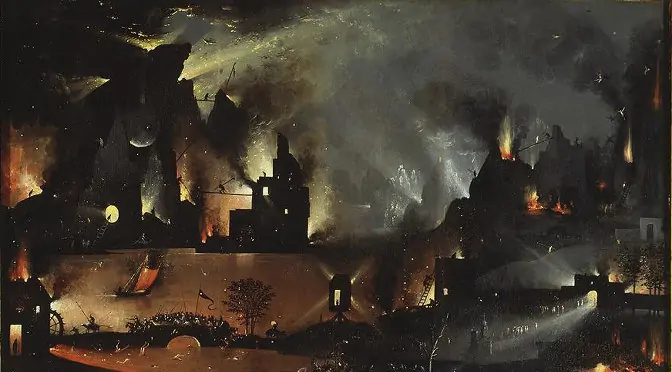可以想象,任何类型的类似自然事件和灾难都会袭击各国,从大流行病到洪水、暴风雪、龙卷风、火灾等。
上集摘要:在 2212 EVT、 Everstate (与我们现实中的国家相对应的理想类型,其目的是 预知 的 治理和现代民族国家的未来)深知其民众的不满情绪日益高涨。面对各种困难和普遍的不满情绪,在第一种情况下,Everstate 的管理机构实施了以下措施 政策 Mamominarch 委员会的结论:通过权力下放、私有化和外包,在五年内大幅削减国家开支的计划。 到了东元 2218 年,结果是内卷化,治理脆弱,包括并意味着国内无法无天现象的抬头,对国际安全的掌控被放弃,经济效率低下,因此,大多数埃弗斯塔人的不安全感不断上升。一系列 惨剧 然后敲 Everstate。
(读者可以点击每张图片,在新的标签页中查看大图--一个 职位导航图 以方便阅读)。

5 月在 Everstate 西部地区爆发的龙卷风以及当年发生的其他悲剧事件,是多年来全球压力累积的结果,包括生态环境方面的压力。
其中两个龙卷风是致命的。它们在 增强型藤田地震烈度表 而且赛道很长,将近 70 公里。
数百座输电塔被摧毁,Everstate 的西部大部分地区因此停电。受灾人口众多。除了死亡、伤亡和下落不明的人之外,还必须加上一夜之间无家可归的人。此外,由于所有的通信都被切断,评估和第一时间急救都非常困难。龙卷风还袭击了 Everstate 最近工业化地区的两个工业基地。一个装有液体废物的水库大坝的一角坍塌,释放出有毒的泥浆。首先,泥浆波到达附近的一个小镇,龙卷风奇迹般地幸免于难,然后泥浆无情地溢出,到达埃弗斯塔坦河干流。
不远处,一家农用化学品公司的仓库被碾成碎片。H剧毒农药的含量是 ****
疫情爆发和最初几天,人们都处于恐慌之中。随之而来的是应对 "复杂灾难 "的极端困难。用美国国防部负责国土防卫和美洲安全事务的助理部长保罗-斯托克顿(Paul N. Stockton)的话来说:
"复杂灾难在两个方面不同于一般灾难。首先,破坏的规模要大得多......其次,......复杂灾难可能会造成关键基础设施的连锁性、全区域性故障,首先是商业电网的中断....,这种电力损失可能会对通信和其他关键基础设施造成连锁影响。从公共安全的角度来看,最直接的问题可能是对市政供水系统的影响,......交通基础设施也可能会受到影响;例如,汽油和柴油燃料泵需要依靠电力才能运转。虽然许多对救灾工作至关重要的医院和其他设施都配备了备用柴油发电机,但我们预计,很少有医院和其他设施手头有足够的燃料来抵消长达数周至数月的停电,而负责为这些设施补给燃料的公司可能会面临严重的供需错配问题"。
在斯托克顿,"9/11 十年之后:未来十年的挑战,” 国土安全事务、 第 7 卷,《9/11 论文集》(2011 年 9 月).*****
在当地,由于西部地区从未发生过任何自然灾害,不在地震带上,也不被视为国防敏感地区,因此不存在对任何自然或人为紧急情况的准备。
与 Novstate 公司签订了全国危机管理和应急响应合同的 Novstate 公司,至少应准备好应急计划的开头部分,并应开始实施。然而,它却没有考虑到几个关键因素。首先,停电大大减缓和延迟了所有通信、评估、运输和后勤工作,同时迅速增加了对民众的危害,尤其是医院备用柴油发电机的燃料将很快耗尽。其次,Novstate 没有计划应对在城市和农村大面积蔓延的此类多风险紧急情况。它主要关注的是 Everstatan 主要城市的恐怖袭击。最后,由于许多不同的公司负责包括医院在内的各类基础设施,并负责各种外包服务,这就造成了一个非常复杂的局面,即必须确定、组织独立的干预行动者,并在紧急、团结和非营利的基础上开展工作。此外,Novstate 的任务规定中并不包括以这种方式行事的具体授权。与此同时,拥有这种合法性的政治当局现在只能依靠减少的 Everstatan 中央行政人员,他们很快就会被从未设想过的灾难类型和规模所淹没。
最后,4 天之后,在同行和地区联盟的国际呼吁下,Everstate 的 首相终于请求国际帮助。 与此同时 数以千计的埃弗勒斯坦人失去了生命;埃弗勒斯坦主河道受到严重污染,有毒泥浆向南部农业区和旅游河口蔓延。有毒粉尘随着强风扩散,只有随着时间的推移才能发现其全部破坏程度,但已对人类健康和生物多样性造成危害,并很可能对土壤和水造成影响。
同样,最初缺乏整体协调的情况与援助的效率背道而驰,因此,地区联盟必须坚定地接管工作,在领导小组中纳入埃弗斯塔坦地区公务员,以尊重 Everstate 的主权和负责紧急情况的新州行政部门。
在国际社会的帮助下,危机终于得到了控制,但要在几个月后才能完全恢复以前被视为理所当然的电力等服务。疫情等更严重的破坏也得以避免。然而,可怕的环境影响依然存在。 此外,接踵而至的干旱使河流干涸,导致有毒泥浆随灰尘扩散到全国更多地区。
埃弗斯塔坦泥潭凸显了复杂灾难管理和干预的高难度,特别是在基础设施私有化和外包的背景下。国际上对其进行了多次审查和批评。因此,Everstate 的模式开始受到严重质疑,这对服务出口产生了间接的负面影响,因为 Everstatan Mamominarch 类型的知识和技能现在被认为是不够的。然而,Novstate 公司却成功地将悲剧转化为自身的优势,现在可以出售其独特的专业知识。
龙卷风爆发造成的直接和间接损失非常巨大。安全肯定得不到保障,而且重建工作进展缓慢,考虑到龙卷风来临前 Everstate 的整体情况已经十分困难,没有希望得到太多帮助,西部难民开始向其他地区迁移。
待续…
——-
* 根据慕尼黑再保险公司(Munich-Re)的数据,"一连串破坏性地震和大量与天气有关的灾难使 2011 年成为有史以来自然灾难损失最惨重的一年....,2011 年发生了约 820 起与损失有关的事件,与过去十年的平均水平持平。记录在案的自然灾害中有 90% 与天气有关--然而,近三分之二的经济损失和约一半的保险损失来自地球物理事件,主要是大地震。通常情况下,与天气有关的自然灾害才是造成损失的主要因素"。Munich-Re, "2011 年自然灾害回顾," 2012 年 1 月 4 日。 下载 pdf.
** 该 视频 由 AssociatedPress 于 2011 年 11 月 17 日发布,并发布在 YouTube 上:"一场龙卷风肆虐了玻利维亚科恰班巴市郊区的三个社区,造成数十栋私人住宅和仓库受损,但没有造成人员死亡。(11 月 17 日)"。最近爆发的破坏性极大的龙卷风的例子,请参阅美国 2011 超级疫情该活动于 2011 年 4 月 25 日至 28 日举行。
*** 这一部分的灵感来自于 阿杰卡氧化铝厂事故 在匈牙利(2010 年 10 月 4 日) - YouTube 上的视频"红色污泥"是由 marta9ful 2010 年 10 月 14 日。
**** 这个想法来自于一个著名的悲惨故事 博帕尔灾难 印度(1984 年 12 月 2-3 日)。观看"灾难后的几秒钟--博帕尔的噩梦 [全集45:05]" 国家地理频道。
***** Stockton 还强调,地方当局需要请求(在美国是请求联邦)帮助。
"及时响应这些请求可能会给[国防部]带来复杂的挑战,包括寻找所需的能力来源、运输这些能力,然后在受到严重破坏的环境中提供这些能力的接收、集结、继续转移和整合"。
推荐图片:博世的三联画《世外桃源》第三部分的一部分,维基共享资源


